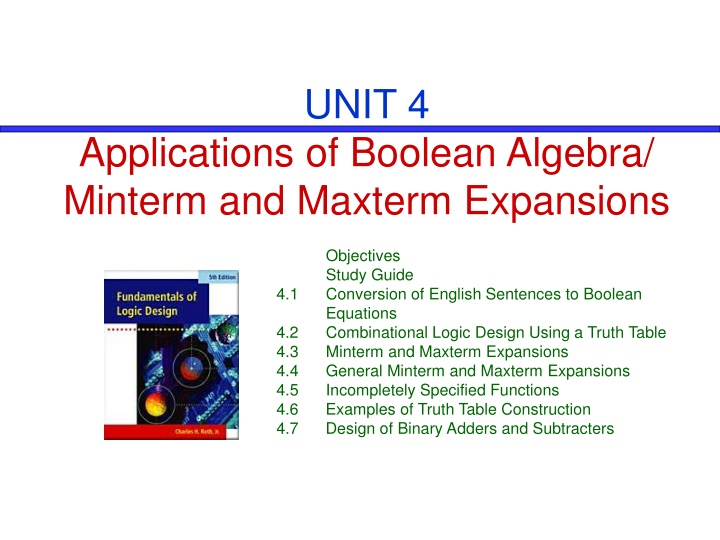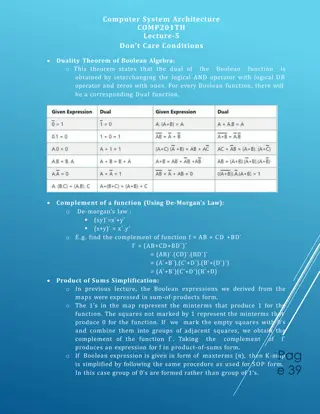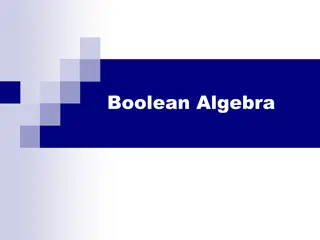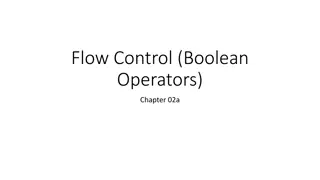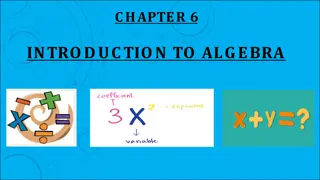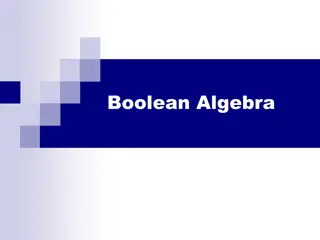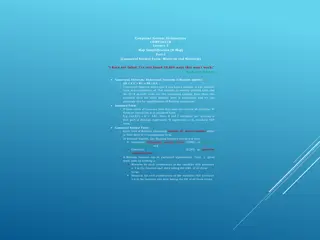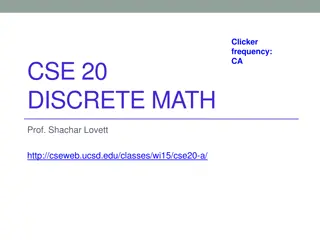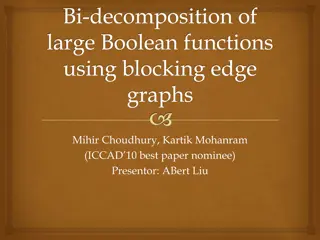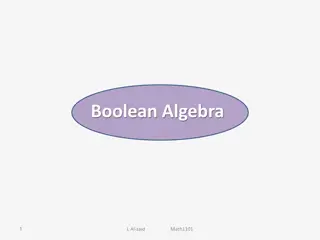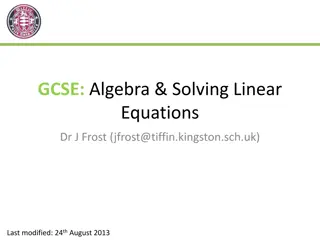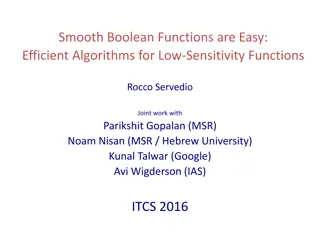Applications of Boolean Algebra: Minterm and Maxterm Expansions
This content explores the application of Boolean algebra in the design of combinational logic circuits using minterm and maxterm expansions. It covers converting English sentences to Boolean equations, designing with truth tables, and examples of circuit constructions such as binary adders and subtracters. Learn about verbal descriptions to Boolean equations and step-by-step design processes with practical examples.
Download Presentation

Please find below an Image/Link to download the presentation.
The content on the website is provided AS IS for your information and personal use only. It may not be sold, licensed, or shared on other websites without obtaining consent from the author.If you encounter any issues during the download, it is possible that the publisher has removed the file from their server.
You are allowed to download the files provided on this website for personal or commercial use, subject to the condition that they are used lawfully. All files are the property of their respective owners.
The content on the website is provided AS IS for your information and personal use only. It may not be sold, licensed, or shared on other websites without obtaining consent from the author.
E N D
Presentation Transcript
UNIT 4 Applications of Boolean Algebra/ Minterm and Maxterm Expansions Objectives Study Guide Conversion of English Sentences to Boolean Equations Combinational Logic Design Using a Truth Table Minterm and Maxterm Expansions General Minterm and Maxterm Expansions Incompletely Specified Functions 4.6 Examples of Truth Table Construction 4.7 Design of Binary Adders and Subtracters 4.1 4.2 4.3 4.4 4.5
Objective Conversion of Verbal Description to Boolean Equations Combinational Logic Design Using a Truth Table Minterm and Maxterm Expansions General Minterm and Maxterm Expansions Incompletely Specified Functions (Don t care term) Examples of Truth Table Construction Design of Binary Adders(Full adder) and Subtracters
4.1 Conversion of Verbal Description to Boolean Equations Steps in designing a single-output combinational switching circuit 1. Find a switching function which specifies the desired behavior of the circuit 2. Find a simplified algebraic expression for the function 3. Realize the simplified function using available logic elements
4.1 Conversion of Verbal Description to Boolean Equations Example Mary watches TV if it is Monday night and she has finished her homework. F = 1 if Mary watches TV is true; otherwise, F = 0; A = 1 if it is Monday night is true; otherwise, A = 0; B = 1 if she has finished her homework is true; otherwise, B = 0; F is true if A and B are both true F = A B
4.1 Conversion of Verbal Description to Boolean Equations 1. Verbal Description The alarm will ring iff the alarm switch is turned on and the door is not closed, or it is after 6PM and window is not closed. Breaking Down The alarm will ring iff Z the alarm switch is turned on A and the door is not closed, B or it is after 6PM C and window is not closed. D
4.1 Conversion of Verbal Description to Boolean Equations 2. Boolean Equation The alarm will ring iff Z the alarm switch is turned on A and the door is not closed, B or it is after 6PM C and window is not closed. D = ' CD + ' Z AB
4.1 Conversion of Verbal Description to Boolean Equations 2. Boolean Equation = ' CD + ' Z AB 3. Circuit Realization
4.2 Combinational Logic Design Using a Truth Table Verbal Description A switching circuit with three inputs and one output The inputs are A, B, and C and represent a binary number N f = 1 if N 0112and f = 0 if N < 0112
4.2 Combinational Logic Design Using a Truth Table Deriving an algebraic expression for f = 1 = + + ' + + ' ' ' ' f A BC AB C AB C ABC ABC Simplifying the algebraic expression + = ' + ' + + ' ' ' ' f A BC AB C + ' AB C ABC ABC = + A BC AB AB = + ' A BC + A = A BC
4.2 Combinational Logic Design Using a Truth Table = + + ' + + ' ' ' ' f A BC AB C AB C ABC ABC Original Equation = + f A BC Simplified Equation Circuit Realization
4.2 Combinational Logic Design Using a Truth Table Expression for f = 0 i.e. f = 1 = + + ' ' ' ' ' ' ' ' f A B C A B C A BC Taking the complement of f = ( )' ' B A f f = + + ( ' ' ' ' ' ' A )' ' C A B C A BC = ( ' ' B )' ' + ( ' ' )' ( + ' )' ' A A B + C A B C BC = + + + ( )( ' )( ' ) A C A B C B C
4.2 Combinational Logic Design Using a Truth Table Expression for f = 0 = + + + + + + ( )( ' )( ' ) f A B C A B C A B C + + = = = = only 0 if 0 A B C A B C + + = = = = ' = only 0 if and 0 1 A B C A B C + + = = = ' only 0 if and 0 1 A B C A C B
4.2 Combinational Logic Design Using a Truth Table Simplifying = + + )( + + + + ' ( )( ' )( ) f A B C A B C A B C = + + + ' ( ) A B A ' B C = + + + + + ' AA AB AC AB BB BC = + + ) + + ) ' ' A AB + AC + AB + BC + = 1 ( ( A C A B B BC = + A BC
4.3 Minterm and Maxterm Expansions Literal A variable or its complement (e.g. A, A ) Minterm of n variables A product of n literals in which each variable appears exactly once in either true or complemented form, but not both Notation mi
4.3 Minterm and Maxterm Expansions Minterm of 3 variables Row No. A B C Minterms Maxterms A B C = m0 A B C = m1 A BC = m2 A BC = m3 AB C = m4 AB C = m5 ABC = m6 ABC = m7 A+B+C = M0 A+B+C = M1 A+B +C = M2 A+B +C = M3 A +B+C = M4 A +B+C = M5 A +B +C = M6 A +B +C = M7 0 1 2 3 4 5 6 7 0 0 0 0 0 1 0 1 0 0 1 1 1 0 0 1 0 1 1 1 0 1 1 1
4.3 Minterm and Maxterm Expansions Sum of minterms Minterm expansion Standard sum of products Canonical sum of products = + + ' + + ' ' ' ' f A BC AB C AB C ABC ABC = + + + + ( , , ) f A B C m m m m m 3 4 5 6 7 = ( , , ) ) 7 , 6 , 5 , 4 , 3 ( m f A B C
4.3 Minterm and Maxterm Expansions Maxterm of n variables A sum of n literals in which each variable appears exactly once in either true or complemented form, but not both Notation Mi
4.3 Minterm and Maxterm Expansions Maxterm of 3 variables Row No. A B C Minterms Maxterms A B C = m0 A B C = m1 A BC = m2 A BC = m3 AB C = m4 AB C = m5 ABC = m6 ABC = m7 A+B+C = M0 A+B+C = M1 A+B +C = M2 A+B +C = M3 A +B+C = M4 A +B+C = M5 A +B +C = M6 A +B +C = M7 0 1 2 3 4 5 6 7 0 0 0 0 0 1 0 1 0 0 1 1 1 0 0 1 0 1 1 1 0 1 1 1
4.3 Minterm and Maxterm Expansions Product of maxterms Maxterm expansion Standard product of sums Canonical product of sums = + + + + + + ( )( ' )( ' ) f A B C A B C A B C = ( , , ) f A B C M M M 0 1 2 = ( , , ) ) 2 , 1 , 0 ( M f A B C
4.3 Minterm and Maxterm Expansions Finding Complement = + + + + ( , , ) f A B C m m m m m 3 4 5 6 7 = + + = ' ) 2 , 1 , 0 ( m f m m m 0 1 2 = ( , , ) f A B C M M M 0 1 2 = = ' ) 7 , 6 , 5 , 4 , 3 ( M f M M M M M 3 4 5 6 7
4.3 Minterm and Maxterm Expansions Minterm and Maxterm expansions are complement each other = + + + + ( , , ) f A B C m m m m m 3 4 5 6 7 = + + + + = ' ( M )' ' ' ' ' ' f m m m m m m m m m m 3 4 5 6 7 3 4 5 6 7 = M M M M 3 4 5 6 7 = ( , , ) f A B C M M M 0 1 2 = = + + ' ( m )' ' 1 ' ' f M M M + M M M 0 + 1 2 m 0 2 = m 0 1 2
4.3 Minterm and Maxterm Expansions Introducing Missing Variables Find the minterm expansion of ? ?,?,?,? = ? ? + ? + ??? ? = ? ? + ? + ??? = ? ? + ? ? + ??? = ? ? ? + ? ? + ? + ? ? ? + ? ? + ? + ??? ? + ? = ? ? ?? + ? ? ?? + ? ? ? ? + ? ? ? ? + ? ??? + ? ?? ? + ? ? ?? + ? ? ? ? + ???? + ?? ?? = ?(3,2,1,0,7,5,3,1,14,10) = ?(0,1,2,3,5,7,10,14) ? = ?(4,6,8,9,11,12,13,15) Maxterm expansion
4.4 General Minterm and Maxterm Expansions Minterm expansion for general function 7 = i = + + + + = ... F a m a m a m a m a im 0 0 1 1 2 2 7 7 i 0 ai =1, minterm miis present ai =0, minterm miis not present General truth table for 3 variables aiis either 0 or 1
4.4 General Minterm and Maxterm Expansions Maxterm expansion for general function 7 = i = + + + + = + ( )( )( )...( ) ( ) F a M a M a M a M a M 0 0 1 1 2 2 7 7 i i 0 ai =1, ai + Mi=1 , Maxterm Miis not present ai =0, Maxterm is present General truth table for 3 variables aiis either 0 or 1
4.4 General Minterm and Maxterm Expansions Finding Complement 7 7 = i = i = = + ( ) F a m a M i i i i 0 0 7 7 7 = i = i = i = + = = ' [ ( ) ]' ' ' ' F a M a M a m i i i i i i 0 0 0 All minterms which are not present in F are present in F
4.4 General Minterm and Maxterm Expansions Finding Complement 7 7 = i = i = = + ( ) F a m a M i i i i 0 0 7 7 7 = i = i = i = = + = + ' [ ]' ( ' ' ) ( ' ) F a m a m a M i i i i i i 0 0 0 All maxterms which are not present in F are present in F
4.4 General Minterm and Maxterm Expansions Generalizing Equations for n Variables n n 2 1 2 1 = i = i = = + ( ) F a m a M i i i i 0 0 n n 2 1 2 1 = i = i = = + ' ' ( ' ) F a m a M i i i i 0 0
4.4 General Minterm and Maxterm Expansions Product of Boolean functions If i and j are different, mi mj= 0 Example = m n = = For , 3 ( ' ' )( ' ) 0 m A B C A BC 1 3 n n 2 1 2 1 = i = j = = Given f a m f b m 1 2 i i j j 0 0 n n n n n 2 1 2 1 2 1 2 1 2 1 = i = j = 0 i = i = = = ( )( ) f f a m b m a b m m a b m 1 2 i i j j i j i j i i i = 0 0 0 0 j f1 f2contains only those minterms which are present in both f1and f2.
4.4 General Minterm and Maxterm Expansions Product of Boolean functions n 2 = i 1 = f f im b a 1 2 i i 0 Example = = , 9 , 5 , 3 , 2 , 0 ( m 11 ) and , 9 , 3 , 0 ( m 11 13 , 14 , ) f f 1 2 = ( 0 , 3 , 11 , 9 ) f f m 1 2
Conversion between minterm and maxterm expansions of F and F DESIRED FORM Minterm Expansion of F Maxterm Expansion of F Minterm Expansion of F Maxterm Expansion of F Maxterm nos. are those nos. not on the minterm list for F Maxterm nos. are the same as minterm nos. of F Minterm Expansion of F List minterms not present in F GIVEN FORM Minterm nos. are those nos. not on the maxterm list for F Minterm nos. are the same as maxterm nos. of F Maxterm Expansion of F List maxterms not present in F
Conversion between minterm and maxterm expansions of F and F For Three Variables DESIRED FORM Minterm Expansion of F Maxterm Expansion of F Minterm Expansion of F Maxterm Expansion of F GIVEN FORM F= m(3,4,5,6,7) M(0,1,2) m(0,1,2) M(3,4,5,6,7) F= M(0,1,2) m(3,4,5,6,7) m(0,1,2) M(3,4,5,6,7)
4.5 Incompletely Specified Functions Don t Care Truth Table with Don t Cares If N1output does not generate all possible combination of A, B, C, the output of N2(F) has don t care values.
4.5 Incompletely Specified Functions Don t Care When realize, assign values which will help simplify the function Case 1: assign 0 on X s = + ' + = + ' ' ' ' ' ' F A B C A BC ABC A B C BC Case 2: assign 1 to the first X and 0 to the second X = + ' + + = + ' ' ' ' ' ' ' F A B C A B C A BC ABC A B BC Case 3: assign 1 on X s = + ' + + + ' = + ' + ' ' ' ' ' ' F A B C A B C A BC ABC ABC A B BC AB The case 2 leads to the simplest function
4.5 Incompletely Specified Functions Notation for Don t Care Terms Minterm expansion for incompletely specified function = + ) 7 , 3 , 0 ( m ) 6 , 1 ( d F Don t Cares Maxterm expansion for incompletely specified function = 5 , 4 , 2 ( ) 6 , 1 ( D ) F M Don t Cares
4.7 Design of Binary Adders and Subtracters Half Adder Truth Table for a Half Adder ? 0 0 1 1 0 1 1 ? 0 ???? ??? 0 0 0 1 0 1 1 1 ???? ? Half Adder ? ??? ? ? ??? ??? = ? ? + ?? = ? ? + ???? ????= ??
4.7 Design of Binary Adders and Subtracters Full Adder Truth Table for a Full Adder ? 0 0 0 1 0 1 0 0 1 1 1 0 0 1 0 1 1 1 0 1 1 1 ? 0 0 ??? ???? ??? 0 0 0 1 0 1 1 0 0 1 1 0 1 0 1 1 ? ? ??? ???? ??? Full Adder ??? ? ? ??? + ????
4.7 Design of Binary Adders and Subtracters Implementation of Full Adder = + + + ' ' ' ' ' in ' Sum X Y C ' X YC ' XY C ' XYC + in in ) in = + + ( ' ( in ' ) X Y C YC + ) X Y C )' YC in C in X in Y = = ( ' ( X Y Y C X C in in + in = + + ) ' ' ' C X ( YC ' XY + C XYC + ( XYC + out in in in ' in = + + ) ( in ' ) X YC + XYC + XY C XYC XYC XYC in in in in in = YC XC XY in in
4.7 Design of Binary Adders and Subtracters Parallel Adder for 4 bit Binary Numbers 1 0 1 1 0 ?? 1 0 1 1 ?? + 1 0 1 1 ?? 1 0 1 1 0 ??
4.7 Design of Binary Adders and Subtracters Parallel Adder Composed of Four Full Adders Carry Ripple Adder (slow!)
4.7 Design of Binary Adders and Subtracters Signed numbers in 1 s complement The end-around carry is accomplished by connecting C4to C0input Signed numbers in 2 s complement The last carry (C4) is discarded, and no carry into the first cell
4.7 Design of Binary Adders and Subtracters Overflow(V) when adding two signed binary number = + ' ' ' V A B S A B S 3 3 3 3 3 3
4.7 Design of Binary Adders and Subtracters Binary Subtracter Using Full Adder Subtraction is done by adding the 2 s complemented number to be subtracted 2 s complemented number
4.7 Design of Binary Adders and Subtracters Parallel Subtracter Using Full Subtracters dn di d2 d1 bn+1 bi+1 bn b1=0 bi b3 b2 Full Full Full Full Subtracter Subtracter Subtracter Subtracter xn yn xi yi x2 y2 x1 y1
4.7 Design of Binary Adders and Subtracters Truth Table For Binary Full Subtracter Bi+1 di 0 0 1 1 1 1 1 0 0 1 0 1 0 0 1 1 xi 0 0 0 0 0 1 0 1 0 0 1 1 1 0 0 1 0 1 1 1 0 1 1 1 yi bi
